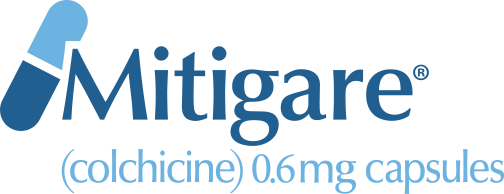
If you suffer with gout, you may take a uric-acid lowering therapy (ULT) such as allopurinol, Uloric (febuxostat), Zurampic® (lesinurad) or Krystexxa® (pegloticase).1-4 These medications have been shown to be a key part of gout flare prevention because they can reduce the amount of uric acid in the bloodstream.1-4,5
ULT represents just one part of therapy, however.6 Many people with gout take ULT and or another anti-inflammatory medicine as part of their gout flare prevention treatment program.6
Understanding gout
Gout is a type of inflammatory arthritis that results from too much uric acid building up in the body, leading to sudden and severe pain, redness and swelling in the joints.7 The disease affects more than 8 million Americans.7
Uric acid builds up over time, so it may take months or even years for symptoms to first appear.8 Once the initial attack has occurred, however, flares usually become more frequent and more painful.7 They eventually begin to occur regularly, with pain that is more severe and long-lasting.7,8 Joints may also be damaged, which can lead to lost mobility.7 These are just some of the reasons why it is so important to gain control of the disease early on—before it becomes chronic.7,8
The importance of ULT
The goals of long-term gout management are to reduce the amount of uric acid in the bloodstream, help dissolve uric acid crystals, reduce the risk of recurrent gout flares, break down tophi (chalk-like deposits under the skin that covers the affected joints) and prevent joint damage.5
The American College of Rheumatology (ACR) recommends a “treat to target” strategy.5 This strategy was devised to help people with gout achieve a uric acid level of less than 6 mg/dL of blood.5 A target uric acid level lower than 5 mg/dL of blood is recommended for people with more severe or aggressive gout.5
The link between ULTs and gout flares
As the ULT reduces the amount of uric acid in the bloodstream, urate crystals in the joints begin to dissolve.5 When the urate crystals start to dissolve, a gout flare can occur.5 Fortunately, when used as directed by a doctor, anti-inflammatory medicines such as colchicine can help prevent gout flares in adults who are beginning ULT.5
Preventing gout flares with ULT and colchicine
The ACR Guidelines for Management of Gout suggest that patients begin an anti-inflammatory medicine before or during ULT.6 Specifically, the ACR recommends low-dose colchicine (0.5 to 0.6 mg orally once or twice a day) as an option for gout flare prevention in adults.6 Research showing the flare prevention benefits of adding colchicine to ULT date as far back as the 1960s.5
Talk with your doctor
If you are taking ULT and still suffering with gout flares, talk with your doctor. Your doctor will be able to offer treatment options that best meet your individual needs and help you avoid the pain of gout flares. You may want to download and complete the Doctor Visit form (from Resources for Patients) before your appointment.
All registered trademarks are the property of their respective owners.
NOTE: This article was not written by a medical professional and is not intended to substitute for the guidance of a physician. These are not West-Ward’s recommendations for gout flare prevention, but rather facts and data collected from various reliable medical sources. For a full list of resources and their attributing links, see below.
